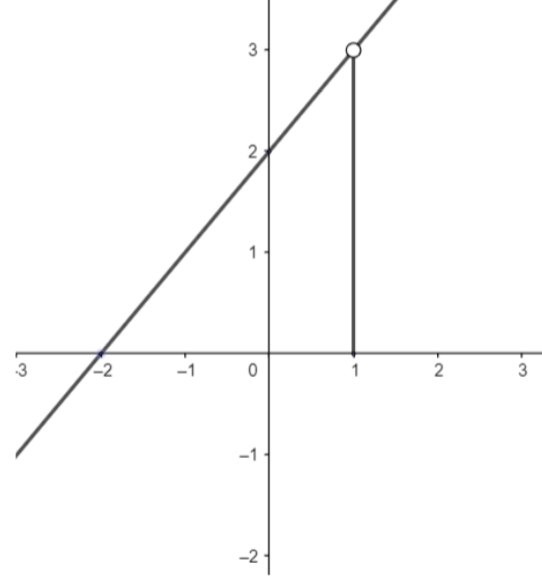
As a final illustration, find the value of \[\underset{x\to 1}{\mathop{\lim }}\,f\left( x \right)\] where
\[f\left( x \right)=\left\{ \begin{matrix}
x+2,x\ne 1 \\
0,x=1 \\
\end{matrix} \right.\]
Answer
608.1k+ views
Hint: The limit of a function exists only if left hand limit and right hand limit exist and both are equal.
Also, the value of the limit will be equal to the value of the right hand limit and (or) the left hand limit.
We know, the limit of a function exists only if the left hand limit and right hand limit exist and both are equal.
So, first, we will find the left hand limit of the function \[f(x)\] at \[x=1\].
We know, the left hand limit of a function\[f\left( x \right)\] at the point \[x=a\] is given as
\[\underset{h\to 0}{\mathop{\lim }}\,f\left( a-h \right)\]
So , the left hand limit of the function\[f\left( x \right)\] at the point\[x=1\] is given as
\[\underset{h\to 0}{\mathop{\lim }}\,f\left( 1-h \right)\]
Now, we know h is a very small quantity and subtracting h from 1 will give a number less than 1 but very close to 1. But, since the number is not equal to 1, so, \[f\left( 1-h \right)=1-h+2\]
So, \[\underset{h\to 0}{\mathop{\lim }}\,f\left( 1-h \right)=\underset{h\to 0}{\mathop{\lim }}\,1-h+2=1-0+2=3\]
Now, we will find the right hand limit of the function\[f\left( x \right)\] at the point \[x=1\].
We know right hand limit of a function \[f\left( x \right)\] at \[x=a\] is given by
\[R.H.L=\underset{h\to 0}{\mathop{\lim }}\, f\left( a+h \right)\]
So, the right hand limit of the function \[f\left( x \right)\] at the point \[x=1\] is given by
\[\underset{h\to 0}{\mathop{\lim }}\, f\left( 1+h \right)\]
Now, we know h is a very small number. So, 1+h will be slightly greater than 1 and not equal to 1. So, \[f\left( 1+h \right)=1+h+2\]
So, \[\underset{h\to 0}{\mathop{\lim }}\,f\left( 1+h \right)=\underset{h\to 0}{\mathop{\lim }}\,\left( 1+h+2 \right)=3\]
We can clearly see that both the left hand limit and the right hand limit of the function \[f\left( x \right)\] exist at the point \[x=1\].
Also, the left hand limit and the right hand limit of the function \[f\left( x \right)\] at the point \[x=1\] are equal.
Since, the value of \[L.H.L=R.H.L\] at \[x=1\], hence, limit of the function \[f\left( x \right)\] exists at \[x=1\] and the value of limit of the function \[f\left( x \right)\]at \[x=1\] is \[3\].
So, \[\underset{x\to 1}{\mathop{\lim }}\,f\left( x \right)=3\]
Note: Graph of \[f\left( x \right)=\left\{ \begin{matrix}
x+2,x\ne 1 \\
0,x=1 \\
\end{matrix} \right.\] is given as

From the graph we can see, just slightly to the left of \[x=1\] and slightly to the right of \[x=1\], the value of \[f\left( x \right)\] is approximately equal to 3.
Hence, the value of \[\underset{x\to 1}{\mathop{\lim }}\,f\left( x \right)=3\].
Also, the value of the limit will be equal to the value of the right hand limit and (or) the left hand limit.
We know, the limit of a function exists only if the left hand limit and right hand limit exist and both are equal.
So, first, we will find the left hand limit of the function \[f(x)\] at \[x=1\].
We know, the left hand limit of a function\[f\left( x \right)\] at the point \[x=a\] is given as
\[\underset{h\to 0}{\mathop{\lim }}\,f\left( a-h \right)\]
So , the left hand limit of the function\[f\left( x \right)\] at the point\[x=1\] is given as
\[\underset{h\to 0}{\mathop{\lim }}\,f\left( 1-h \right)\]
Now, we know h is a very small quantity and subtracting h from 1 will give a number less than 1 but very close to 1. But, since the number is not equal to 1, so, \[f\left( 1-h \right)=1-h+2\]
So, \[\underset{h\to 0}{\mathop{\lim }}\,f\left( 1-h \right)=\underset{h\to 0}{\mathop{\lim }}\,1-h+2=1-0+2=3\]
Now, we will find the right hand limit of the function\[f\left( x \right)\] at the point \[x=1\].
We know right hand limit of a function \[f\left( x \right)\] at \[x=a\] is given by
\[R.H.L=\underset{h\to 0}{\mathop{\lim }}\, f\left( a+h \right)\]
So, the right hand limit of the function \[f\left( x \right)\] at the point \[x=1\] is given by
\[\underset{h\to 0}{\mathop{\lim }}\, f\left( 1+h \right)\]
Now, we know h is a very small number. So, 1+h will be slightly greater than 1 and not equal to 1. So, \[f\left( 1+h \right)=1+h+2\]
So, \[\underset{h\to 0}{\mathop{\lim }}\,f\left( 1+h \right)=\underset{h\to 0}{\mathop{\lim }}\,\left( 1+h+2 \right)=3\]
We can clearly see that both the left hand limit and the right hand limit of the function \[f\left( x \right)\] exist at the point \[x=1\].
Also, the left hand limit and the right hand limit of the function \[f\left( x \right)\] at the point \[x=1\] are equal.
Since, the value of \[L.H.L=R.H.L\] at \[x=1\], hence, limit of the function \[f\left( x \right)\] exists at \[x=1\] and the value of limit of the function \[f\left( x \right)\]at \[x=1\] is \[3\].
So, \[\underset{x\to 1}{\mathop{\lim }}\,f\left( x \right)=3\]
Note: Graph of \[f\left( x \right)=\left\{ \begin{matrix}
x+2,x\ne 1 \\
0,x=1 \\
\end{matrix} \right.\] is given as

From the graph we can see, just slightly to the left of \[x=1\] and slightly to the right of \[x=1\], the value of \[f\left( x \right)\] is approximately equal to 3.
Hence, the value of \[\underset{x\to 1}{\mathop{\lim }}\,f\left( x \right)=3\].
Recently Updated Pages
Master Class 11 Chemistry: Engaging Questions & Answers for Success

Why are manures considered better than fertilizers class 11 biology CBSE

Find the coordinates of the midpoint of the line segment class 11 maths CBSE

Distinguish between static friction limiting friction class 11 physics CBSE

The Chairman of the constituent Assembly was A Jawaharlal class 11 social science CBSE

The first National Commission on Labour NCL submitted class 11 social science CBSE

Trending doubts
What is meant by exothermic and endothermic reactions class 11 chemistry CBSE

10 examples of friction in our daily life

One Metric ton is equal to kg A 10000 B 1000 C 100 class 11 physics CBSE

Difference Between Prokaryotic Cells and Eukaryotic Cells

What are Quantum numbers Explain the quantum number class 11 chemistry CBSE

1 Quintal is equal to a 110 kg b 10 kg c 100kg d 1000 class 11 physics CBSE




